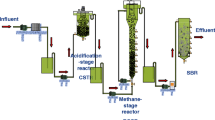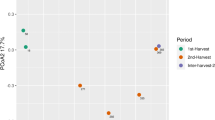Abstract
The microbial communities (Bacteria and Archaea) established in an anaerobic fluidized bed reactor used to treat synthetic vinasse (betaine, glucose, acetate, propionate, and butyrate) were characterized by denaturing gradient gel electrophoresis (DGGE) and phylogenetic analysis. This study was focused on the competitive and syntrophic interactions between the different microbial groups at varying influent substrate to sulfate ratios of 8, 4, and 2 and anaerobic or micro-aerobic conditions. Acetogens detected along the anaerobic phases at substrate to sulfate ratios of 8 and 4 seemed to be mainly involved in the fermentation of glucose and betaine, but they were substituted by other sugar or betaine degraders after oxygen application. Typical fatty acid degraders that grow in syntrophy with methanogens were not detected during the entire reactor run. Likely, sugar and betaine degraders outnumbered them in the DGGE analysis. The detected sulfate-reducing bacteria (SRB) belonged to the hydrogen-utilizing Desulfovibrio. The introduction of oxygen led to the formation of elemental sulfur (S0) and probably other sulfur compounds by sulfide-oxidizing bacteria (γ-Proteobacteria). It is likely that the sulfur intermediates produced from sulfide oxidation were used by SRB and other microorganisms as electron acceptors, as was supported by the detection of the sulfur respiring Wolinella succinogenes. Within the Archaea population, members of Methanomethylovorans and Methanosaeta were detected throughout the entire reactor operation. Hydrogenotrophic methanogens mainly belonging to the genus Methanobacterium were detected at the highest substrate to sulfate ratio but rapidly disappeared by increasing the sulfate concentration.






Similar content being viewed by others
References
Angelidaki I, Alves M, Bolzonella D, Borzacconi L, Campos JL, Guwy AJ, Kalyuzhnyi S, Jenicek P, van Lier JB (2009) Defining the biomethane potential (BMP) of solid organic wastes and energy crops: a proposed protocol for batch assays. Water Sci Technol 59(5):927–934
Ben-Amor K, Heilig H, Smidt H, Vaughan EE, Abee T, de Vos WM (2005) Genetic diversity of viable, injured, and dead fecal bacteria assessed by fluorescence-activated cell sorting and 16S rRNA gene analysis. Appl Environ Microbiol 71:4679–4689
Castro HF, Williams NH, Ogram A (2000) Phylogeny of sulfate-reducing bacteria. FEMS Microbiol Ecol 31:1–9
Clesceri LS, Greenberg AE, Eaton AD (1998) Standard methods for the examination of water and wastewater. American Public Health Association, Washington, DC
Colleran E, Finnegan S, Lens P (1995) Anaerobic treatment of sulfate-containing waste streams. Antonie van Leeuwenhoek 67:29–46
de Menezes TJB (1989) The treatment and utilization of alcohol stillage. In: Wise DL (ed) International Biosystems, vol III. CRC Press, Boca Raton, FL, pp 1–14
Diekert G, Wohlfarth G (1994) Metabolism of homoacetogens. Antonie van Leeuwenhoek 66:209–221
Grosskopf R, Janssen PH, Liesack W (1998) Diversity and structure of the methanogenic community in anoxic rice paddy soil microcosms as examined by cultivation and direct 16S rRNA gene sequence retrieval. Appl Environ Microbiol 64:960–969
Gupta A, Flora JRV, Gupta M, Sayles GD, Suidan MT (1994) Methanogenesis and sulfate reduction in chemostats-I. Kinetic studies and experiments. Water Res 28:781–793
Janssen AJH, Lettinga G, de Keizer A (1999) Removal of hydrogen sulfide from wastewater and waste gases by biological conversion to elemental sulfur: colloidal and interfacial aspects of biologically produced sulfur particles. Colloids Surf A 151:389–397
Kobayashi T, Li Y-Y, Kubota K, Harada H, Maeda T, Yu H-Q (2011) Characterization of sulfide-oxidizing microbial mats developed inside a full-scale anaerobic digester employing biological desulfurization. Appl Microbiol Biotechnol:1–11. doi:10.1007/s00253-011-3445-6
Kumar S, Tamura K, Nei M (1994) MEGA: Molecular Evolutionary Genetics Analysis software for microcomputers. Comput Appl Biosci 10:189–191
Laanbroek HJ, Geerligs HJ, Sijtsma L, Veldkamp H (1984) Competition for sulfate and ethanol among Desulfobacter, Desulfobulbus, and Desulfovibrio species isolated from intertidal sediments. Appl Environ Microbiol 47:329–334
Lane D (1991) 16S/23S rRNA sequencing. In: Stackebrandt E, Goodfellow M (eds) Nucleic acid techniques in bacterial systematics. Wiley and Sons Ltd, Chichester, UK, pp 115–175
Leclerc M, Delgenes JP, Godon JJ (2004) Diversity of the archaeal community in 44 anaerobic digesters as determined by single strand conformation polymorphism analysis and 16S rDNA sequencing. Environ Microbiol 6:809–819
McCartney DM, Oleskiewicz JA (1991) Sulfide inhibition of anaerobic degradation of lactate and acetate. Water Res 25:203–209
McGinnis S, Madden TL (2004) BLAST: at the core of a powerful and diverse set of sequence analysis tools. Nucleic Acids Res 32:W20–W25
Muyzer G, Dewaal EC, Uitterlinden AG (1993) Profiling of complex microbial-populations by denaturing gradient gel-electrophoresis analysis of polymerase chain reaction-amplified genes-coding for 16S ribosomal-RNA. Appl Environ Microbiol 59:695–700
Muyzer G, Stams AJM (2008) The ecology and biotechnology of sulfate-reducing bacteria. Nat Rev Microbiol 6:441–454
Nawrocki EP, Kolbe DL, Eddy SR (2009) Infernal 1.0: inference of RNA alignments. Bioinformatics 25(10):1335–1337
Nielsen MB, Kjeldsen KU, Ingvorsen K (2006) Desulfitibacter alkalitolerans gen. nov., sp. nov., an anaerobic, alkalitolerant, sulfite-reducing bacterium isolated from a district heating plant. Int J Syst Evol Microbiol 56:2831–2836
Nübel U, Engelen B, Felske A, Snaidr J, Wieshuber A, Amann RI, Ludwig W, Backhaus H (1996) Sequence heterogeneities of genes encoding 16S rRNAs in Paenibacillus polymyxa detected by temperature gradient gel electrophoresis. J Bacteriol 178:5636–5643
O’Flaherty V, Lens P, Leahy B, Colleran E (1998) Long-term competition between sulfate-reducing and methane-producing bacteria during full-scale anaerobic treatment of citric acid production wastewater. Water Res 32:815–825
Omil F, Lens P, Hulshoff Pol L, Lettinga G (1996) Effect of upward velocity and sulfide concentration on volatile fatty acid degradation in a sulfidogenic granular sludge reactor. Process Biochem 31:699–710
Oude Elferink SJWH, Maas RN, Harmsen HJM, Stams AJM (1995) Desulforhabdus amnigenus gen. nov., sp. nov., a sulfate reducer isolated from anaerobic granular sludge. Arch Microbiol 164:119–124
Rivers-Singleton JR (1993) The sulfate-reducing bacteria: an overview. In: Odom JM, Rivers-Singleton JR (eds) The sulfate-reducing bacteria: contemporary perspectives. Springer, New York, pp 1–20
Roest K, Heilig HG, Smidt H, de Vos WM, Stams AJM, Akkermans ADL (2005a) Community analysis of a full-scale anaerobic bioreactor treating paper mill wastewater. Syst Appl Microbiol 28:175–185
Roest K, Altinbas M, Paulo PL, Heilig HGHJ, Akkermans ADL, Smidt H, de Vos WM, Stams AJM (2005b) Enrichment and detection of microorganisms involved in direct and indirect methanogenesis from methanol in an anaerobic thermophilic bioreactor. Microb Ecol 50:440–446
Sass A, Rutters H, Cypionka H, Sass H (2002) Desulfobulbus mediterraneus sp. nov., a sulfate-reducing bacterium growing on mono- and disaccharides. Arch Microbiol 177:468–474
Schink B, Stams AJM (2006) Syntrophism among prokaryotes. In: Dworkin M, Schleifer K-H and Stackebrandt E (ed) The Prokaryotes, Springer Verlag. N Y 2:309–335
Sousa DZ, Alves JI, Alves MM, Smidt H, Stams AJM (2009) Effect of sulfate on methanogenic communities that degrade unsaturated and saturated long-chain fatty acids (LCFA). Environ Microbiol 11:68–80
Speece RE (1983) Anaerobic biotechnology for industrial wastewater treatment. Env Sci Technol 17:416A–427A
Stams AJM, Hansen TA, Skyring GW (1985) Utilization of amino acids as energy substrates by two marine Desulfovibrio strains. FEMS Microbiol Ecol 31:11–15
Stams AJM, Plugge CM, de Bok FAM, van Houten BHGW, Lens P, Dijkman H, Weijma J (2005) Metabolic interactions in methanogenic and sulfate-reducing bioreactors. Water Sci Technol 52(1–2):13–20
van den Ende FP, van Gemerden H (1993) Sulfide oxidation under oxygen limitation by Thiobacillus thioparus. FEMS Microbiol Ecol 13:69–78
van den Ende FP, Meier J, Gemerden H (1997) Syntrophic growth of sulfate-reducing bacteria and colorless sulfur bacteria during oxygen limitation. FEMS Microbiol Ecol 23:65–80
van der Zee FP, Villaverde S, García PA, Fdz.-Polanco F (2007) Sulfide removal by moderate oxygenation of anaerobic sludge environments. Bioresour Technol 98:518–524
van Haandel AC, Catunda PFC (1994) Profitability increase of alcohol distilleries by the rational use of byproducts. Water Sci Technol 29(8):117–124
Voordouw G (1995) The genus Desulfovibrio: the centennial. Appl Environ Microbiol 61:2813–2819
Wang Q, Garrity GM, Tiedje JM, Cole JR (2007) Naive Bayesian classifier for rapid assignment of rRNA sequences into the new bacterial taxonomy. Appl Environ Microbiol 73:5261–5267
Weijma J, Gubbels F, Hulshoff Pol LW, Stams AJ, Lens P, Lettinga G (2002) Competition for H2 between sulfate reducers, methanogens and homoacetogens in a gas-lift reactor. Water Sci Technol 45(10):75–80
Zehnder AJB, Stumm W (1988) Geochemistry and biogeochemistry of anaerobic habitats. In: Zehnder AJB (ed) Biology of Anaerobic Microorganisms. John Wiley and Sons, New York, pp 1–38
Acknowledgments
This research was supported by the Spanish Ministry of Education and Science (contract project CTQ2007-64324 and CONSOLIDER-CSD 2007–00055). The Regional Government of Castilla y Leon (Ref. VA038A07) is also gratefully acknowledged. The authors wish to thank to Lorena López and Irene Sánchez for helpful in sequence analysis.
Author information
Authors and Affiliations
Corresponding author
Rights and permissions
About this article
Cite this article
Rodríguez, E., Lopes, A., Fdz.-Polanco, M. et al. Molecular analysis of the biomass of a fluidized bed reactor treating synthetic vinasse at anaerobic and micro-aerobic conditions. Appl Microbiol Biotechnol 93, 2181–2191 (2012). https://doi.org/10.1007/s00253-011-3529-3
Received:
Revised:
Accepted:
Published:
Issue Date:
DOI: https://doi.org/10.1007/s00253-011-3529-3




